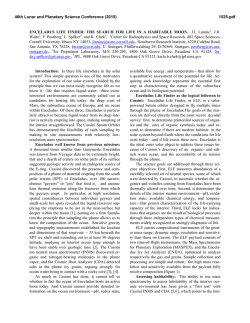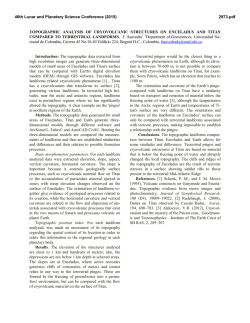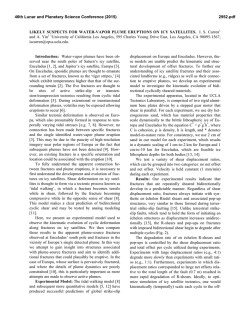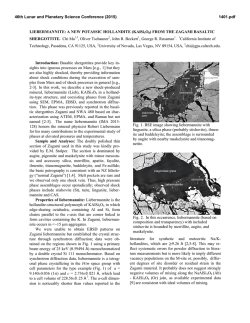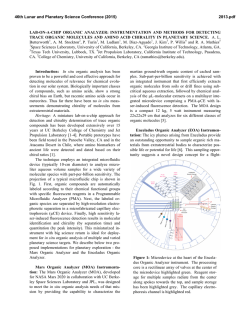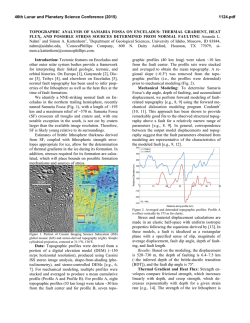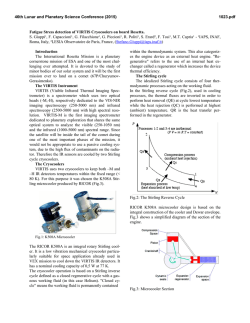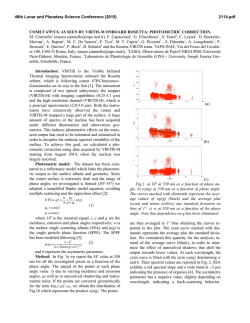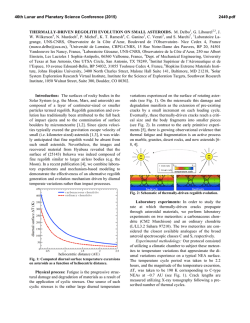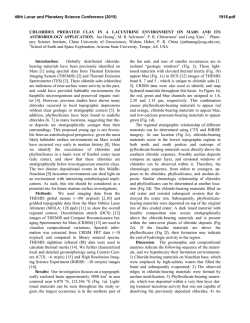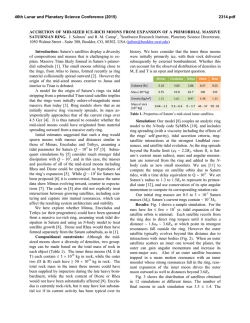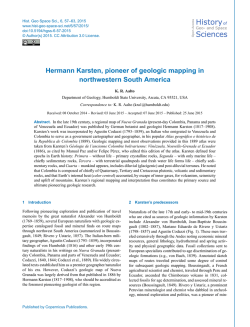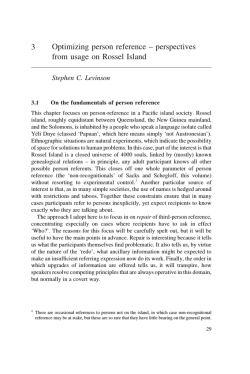
A NEW ENCELADUS BASE MAP AND GLOBAL CONTROL
46th Lunar and Planetary Science Conference (2015) 2303.pdf A NEW ENCELADUS BASE MAP AND GLOBAL CONTROL NETWORK IN SUPPORT OF GEOLOGIC MAPPING. M. T. Bland1, T. L. Becker1, K. L. Edmundson1, G. W. Patterson2, G. C. Collins3, R. T. Pappalardo4, S. A. Kattenhorn5, T. Roatsch6, and P. M. Schenk7, 1U. S. Geological Survey, Astrogeology Science Center, Flagstaff AZ ([email protected]), 2The Johns Hopkins University/Applied Physics Laboratory, Laurel, MD, 3Department of Physics and Astronomy, Wheaton College, Norton, MA, 4Jet Propulsion Laboratory, California Institute of Technology, Pasadena CA, 5Dept. Geological Sciences, U. of Idaho, Moscow, ID, 6Institute of Planetary Research, DLR, Berlin, 7Lunar and Planetary Institute, Houston, TX. Summary: From its active south polar terrain, to its heavily tectonized equatorial regions, to its midlatitude viscously relaxed craters, Enceladus presents a diverse set of geologic provinces that record a complex geologic history. Fully unraveling the evolution of Enceladus’ surface requires integrating disparate observations and insights from across the satellite into a single self-consistent geologic history–a task that requires global geologic mapping. In support of a new global mapping effort, we have begun preliminary work on an updated global control network and base map for Enceladus. The new, technically robust, datarich, well-documented network and base map will enable high-fidelity mapping of Enceladus and enhance future investigations of the satellite. Motivation for a New Control Network and Base Map: The creation of a global geologic map requires a robust control network from which a global base map can be created. Several base maps have already been produced for Enceladus [e.g., 1, 2, 3, 4]. Here we expand upon these existing maps by creating a new control network that has both high tie-point spatial density and depth (multiple image measurements per surface point). The resulting updated NAIF SPICE kernels [5] will be used to create a global mosaic for mapping, and will subsequently be documented and made available to the community through the Integrated Software for Imagers and Spectrometers (ISIS3) [6] environment. The updated kernels also permit the accurate projection and placement of additional images selected by the mapper on an as-needed basis, facilitating dynamic analysis of images taken at different times, phase angles, and resolution in a given region. Enceladus Imaging Data: The Enceladus imaging dataset acquired by Cassini provides a number of challenges to those mapping or analyzing its surface. Whereas near-global coverage is available at resolutions better than 200 m/px (image resolution is lower near the North Pole), the small size of Enceladus, the geometry of Cassini’s flybys, and the desire to acquire high-phase images for plume observations has resulted in a broad range of viewing geometries. The identification of linear surface features, which dominate large regions of Enceladus, depends strongly on viewing angle (Fig. 1). Image registration between high phase and low phase images is therefore challenging. Comparing and mapping geographically co-located images therefore necessitates the development of a robust control network. Basic Approach: Our preliminary global control network is being created from ~370 Cassini Imaging Science Subsystem (ISS) images with resolution better than 1 km/px. We initially focus on clear and green filter images (651 and 569 nm effective wavelength, respectively), supplemented by other filters in a limited number of regions with low image coverage. Additional filters will be included as resources permit. All images were ingested into ISIS3 for processing and control network development. Fig. 1: (A, B) Examples of calibrated, un-projected image cubes used in the control network. Red crosses indicate locations of control points. Yellow box in A indicates approximate position of image in C. Portion of images A and B are shown in C and D (respectively) but sub-pixel registered and re-projected (polar stereographic). Note how prominent east-west oriented features in D are harder to identify in C. Because the south pole has been more extensively imaged than the satellite in general, we have subdivided control network development into a higherresolution south pole network consisting of 94 images with resolution better than 160 m/px, and a lowerresolution global network. The two networks will ulti- 46th Lunar and Planetary Science Conference (2015) mately be combined into a single global network. The south pole network is near completion (results described here) and work has begun on the global network. Control points are distributed with sufficient density to ensure complete coverage across each image (Fig. 1A and B). Each control point ties together multiple images (i.e., “measures”), creating a “deeper” control network than previous efforts (Figs. 1 and 2). Our south polar control network currently includes 1504 control points and 5108 total measures. More than 63% of the control points have >2 measures and 20% have >4 –a substantial increase over previous networks (Fig. 2). 2303.pdf provided to community users in the form of updated (smithed) pointing (CK) kernels, which replace the original reconstructed kernels. These improved kernels will facilitate future analysis of the Cassini imaging dataset. Additionally, by solving for local radius, the control network may help determine Enceladus’ largescale topography [cf. 9], and plausibly constrain the satellite’s physical libration [10]. Acknowledgements: This work is supported by NASA’s PGG #NNX14AM89G. References: [1] Roatsch, T. et al. (2008) Planet. Space Sci., 56, 109-116. [2] Roatsch, T. et al. (2013) Planet. Space Sci., 77, 118-125. [3] Schenk, P. M. (2014) Planet. Rep. 34, no 3, 8-13. [4] Crow-Willard, E. N. and Pappalardo, R. T. (submitted) Icarus. [5] Acton, C.H., et al. (1996) Planet. Space Sci., 44(1), 65-70. [6] Kestay, L., et al. (2014) LPS XLV, Abstract #1686. [7] Edmundson, K. L. et al. (2012) ISPRS Ann. Photogramm. Remote Sens. Info. Sci., I-4, 203208. [8] Edmundson, K. L. et al. (2015) this conf. [9] Schenk P. M. and McKinnon W. B. (2009) GRL, 36, L16202. [10] Giese, B. et al. (2011) EPSC-DPS Joint Meeting, 6, 976. Fig. 2: A. Number of control points with a given number of measures (images). Inset zooms in on region with >7 measures. B. Percentage of control points with a given number of measures. Nearly 40% of control points have at least four measures–a substantial increase over previous efforts. For each control point, images are registered with sub-pixel accuracy using a maximum correlation algorithm. Bundle adjustment is performed using the ISIS3 jigsaw module [7,8] to update spacecraft pointing. The updated pointing is then used to project images with consistent resolution and geometry for use in constructing the global base map. Preliminary Results: Our current south polar control network has undergone bundle adjustment to update spacecraft pointing and the 3D coordinate of each point, resulting in an image measure RMS residual of 0.56 pixels. We continue to work to refine our control network to further decrease residual magnitude. An example of the improvement in registration afforded by the bundle adjustment is illustrated in Fig. 3. Community Benefit and Lagniappes: Once a final control network is complete, the results will be Fig. 3: Example of uncontrolled (A) and controlled (B) mosaic illustrating the improved registration provided by jigsaw. Images are ~39 km across.
© Copyright 2025
